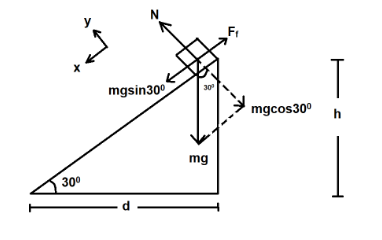
What is the acceleration of the box?


Answer
455.1k+ views
Hint: We know that total force on an object remains zero. Here, we will take the box as the object and then will equate all the forces acting on it.
Formulae Used: $ F = ma $
Where, $ F $ is the force on the object, $ m $ is its mass and $ a $ is its acceleration.
$ tan\theta = p/b $
Where, $ \theta $ is the angle of inclination, $ p $ is the perpendicular height and $ b $ is the base length.
Complete Step By Step Solution
Let us assume that the box accelerate down the slope,
Then, We know that Frictional Constant, $ \mu = tan\theta $
Here, $ \theta = {30^0} $
Thus, After calculating, we get
$ \mu = 1/\surd 3 $
Now, $ mgsin{30^0} = {F_f} $
Also, $ {F_f} = \mu N $
But, N=mgcos300
$ N = \surd 3mg $
Now, $ ma = {F_f} $
Thus, $ mgsin{30^0} = ma $
We know, $ g = 9.81m{s^{ - 2}} $
Thus, $ a = g \times \left( {1/2} \right) $
After calculating, we get
$ a = 4.905m{s^{ - 2}} $
Thus, the acceleration of the box is $ 4.905{\text{ }}m{s^{ - 2}} $ .
Additional Information
The diagram we dealt upon is known as free body diagram in scientific terminology. It is actually a schematic representation of a real life problem taking into account the relative magnitudes and force acting on an object in a given situation.
The frictional constant $ \mu $ multiplied by the mass of the target object is the value up till which the object is acted upon by static friction and beyond this barrier the friction gets converted into kinetic friction. The value of kinetic friction is a bit lower than that of the static friction. In other words, we can say that the barrier is after which a body starts to move.
Note
The value we calculated is by taking $ g = 9.81m{s^{ - 2}} $ , but we could also approximate and take $ g = 10m{s^{ - 2}} $ . For that the value of acceleration comes out to be $ 5m{s^{ - 2}} $ .
Formulae Used: $ F = ma $
Where, $ F $ is the force on the object, $ m $ is its mass and $ a $ is its acceleration.
$ tan\theta = p/b $
Where, $ \theta $ is the angle of inclination, $ p $ is the perpendicular height and $ b $ is the base length.
Complete Step By Step Solution
Let us assume that the box accelerate down the slope,
Then, We know that Frictional Constant, $ \mu = tan\theta $
Here, $ \theta = {30^0} $
Thus, After calculating, we get
$ \mu = 1/\surd 3 $
Now, $ mgsin{30^0} = {F_f} $
Also, $ {F_f} = \mu N $
But, N=mgcos300
$ N = \surd 3mg $
Now, $ ma = {F_f} $
Thus, $ mgsin{30^0} = ma $
We know, $ g = 9.81m{s^{ - 2}} $
Thus, $ a = g \times \left( {1/2} \right) $
After calculating, we get
$ a = 4.905m{s^{ - 2}} $
Thus, the acceleration of the box is $ 4.905{\text{ }}m{s^{ - 2}} $ .
Additional Information
The diagram we dealt upon is known as free body diagram in scientific terminology. It is actually a schematic representation of a real life problem taking into account the relative magnitudes and force acting on an object in a given situation.
The frictional constant $ \mu $ multiplied by the mass of the target object is the value up till which the object is acted upon by static friction and beyond this barrier the friction gets converted into kinetic friction. The value of kinetic friction is a bit lower than that of the static friction. In other words, we can say that the barrier is after which a body starts to move.
Note
The value we calculated is by taking $ g = 9.81m{s^{ - 2}} $ , but we could also approximate and take $ g = 10m{s^{ - 2}} $ . For that the value of acceleration comes out to be $ 5m{s^{ - 2}} $ .
Recently Updated Pages
Glucose when reduced with HI and red Phosphorus gives class 11 chemistry CBSE

The highest possible oxidation states of Uranium and class 11 chemistry CBSE

Find the value of x if the mode of the following data class 11 maths CBSE

Which of the following can be used in the Friedel Crafts class 11 chemistry CBSE

A sphere of mass 40 kg is attracted by a second sphere class 11 physics CBSE

Statement I Reactivity of aluminium decreases when class 11 chemistry CBSE

Trending doubts
10 examples of friction in our daily life

Difference Between Prokaryotic Cells and Eukaryotic Cells

One Metric ton is equal to kg A 10000 B 1000 C 100 class 11 physics CBSE

State and prove Bernoullis theorem class 11 physics CBSE

What organs are located on the left side of your body class 11 biology CBSE

Define least count of vernier callipers How do you class 11 physics CBSE




